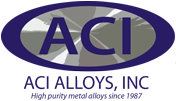Thin Film Materials-Overview and Common Applications
Thin films have thousands uses for both of everyday items and highly specialized technologies. Using thin film materials or rather the application of a thin film to a product or component is called deposition. The term deposition, itself, is really any technique that affixes a fine layer of material onto a substrate or the surface of an object. Generally, this process is accomplished through two main categories of deposition–chemical deposition or via physical deposition.
For example, everyday household mirrors were previously made using a similar technique known as silvering. Today, the application of different materials to other components typically occurs either with optical coatings or electronic semiconductor devices. Here, at ACI Alloys, we offer a thin film material for all types of applications. We can make high purity custom alloys, precious metals, ceramics and non-precious metals.
Commonly Used Types of Thin Film Materials
As previously mentioned, other commonly used films include a range of metals, non-metals such as ceramics and PVD materials all of which are ideal for creating specific kinds of thin films. Depending on your specific needs, materials that are affixed or sputtered using Physical Vapor Deposition (PVD) can be customized to the level of quality and the exact size you desire. We can also provide ceramics- ceramic films are another commonly used to creates a protective layer against oxidation, wear and corrosion.
Typically, this particular material is perfect for extending the longevity of tools as well as other products or components that are prone to wear and tear. Ultimately, if you are having trouble finding the material you hope to use for your application, our experts at ACI Alloys have the experience to find a way to make the thin film materials that you need.
The Difference between Physical and Chemical Deposition
With chemical deposition, fluid precursors essentially change a solid surface on a chemical level. In other words, a particular fluid surrounds a solid component and the process of deposition therefore occurs completely on every surface without any real opportunity for customization. Physical deposition, on the other hand, uses electromechanical, thermodynamic or mechanical methods to create the film or coating.
Benefits of Thin Film Application
The benefits of thin film application are almost endless, since films, PVD materials and coatings are used in almost every industry. Typically, coatings and films provide a specific protective function.
